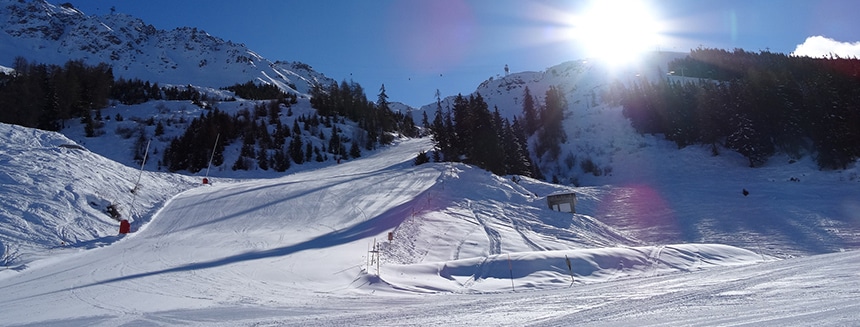
A good instructor doesn’t use complicated jargon, technical words or unfamiliar terms you don’t understand. They will communicate clearly and simply, in a way that you can relate to.
However. There does exist a language, and a group of words that skiers often use. This article will provide you with some common ski terminology that might be useful when you are learning to or improving your skiing.
Balance
A brick sitting on a flat piece of ground is in balance a person skiing is balancing. Movements, speed and bumps in the snow all conspire to send your body away from the centre; balancing is just the act of trying continuously to go back to the centre. Poorly balanced skiers make bigger and cruder movements to get back to the centre. Better balanced people make smaller more subtle movements to do the same thing. Think of a drunken sailor wobbling about.
Fall line
Sounds worse than it is. The fall line is simply the path straight down the hill, the way a ball would roll if you let it go on a slope.
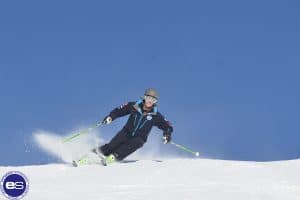
Carve
Carve usually refers a type of turn or technique. There is a myth that carving only happened since the invention of shaped skis, but not so, people carved before this. A carved turn involves no skid. The ski runs along its curved, shaped edges. Skiing like this offers no or very little resistance so is fast and dynamic. The opposite of carving is skidding; this involves the skis turning but also going sideways a little bit, like a knife spreading butter on toast. Yum.
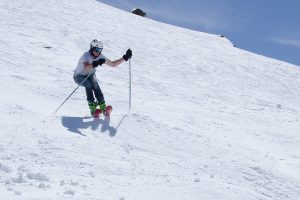
The Mogul
If your instructor tells you the mogul, (a small bump sized anywhere between a mole hill and a VW beetle laid out in a pattern usually on steeper slopes) is the result of the Alpine Mogue, a large mole-like animal digging tunnels he or she is possibly winding you up. Moguls are formed by skiers turning. Skiing them can be fun if you know how but it can take a long time to learn. Practice and lots of lessons help. Moguls form on steeper slopes but sometimes there are moguls on shallower pistes; usually in bottlenecks or high-traffic areas.

Side Cut
This is the shape of the ski as you see it from above when it is on the snow, usually narrow in the middle and wider at each end. This shape forms a curve. This curve if extended would form a circle, which would have a radius. Your ski’s radius is usually marked on your skis. As is the width at each end and in the middle. This might look like this. Skis with a smaller radius (like slalom skis) are generally a little easier to turn, while skis with a larger radius are more suited to skiing fast (like GS skis).

Camber
If you lay your skis flat on the ground the tips point up, but the middle of the ski will also be off the ground. The middle of the ski will also be thicker. This shape and thickness are there to spread your weight out more evenly along the ski. This camber ensures the front and the back of the skis have some pressure and the wide bits, the side cut, can get some traction in the snow to help you turn.
Bindings
The bindings connect your foot to the ski. Traditionally, they are mounted so the front of our foot is over the middle of the ski or the highest point in the camber, the top of the ski as seen in profile. The front of your foot is the bit you balance on; it is also the strongest part of the foot where we put our weight. By positioning it over the top of the camber, your weight is most effectively spread out across the ski. This mounting position looks like it is slightly towards the back of the ski.
Some skis for park skiers are centrally mounted. Park skiers do tricks in the air, as you rotate or twist a centrally mounted ski spins easily while a traditionally mounted ski rotates the skier off-axis making landings difficult.
Edges and Edging
Your skis have metal edges running along the sides; periodically these are sharpened and allow you to grip on the piste, which helps you turn. Having sharp edges is important, especially if conditions are bad or the snow is very hard.
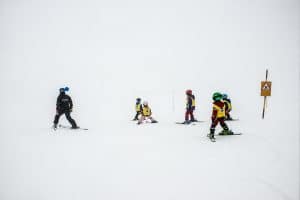
Snowplough
Snowplough is the ubiquitous manoeuvre beginners learn first to control their speed. The name is an unfortunate one; it implies to the novice the skis will dig into the snow, pushing it aside like a snow plough. Ideally, this is not the case; any pushing should be slight, the skis making a V-shape in the snow. It is the width of the V gliding over the snow, with only a small amount of ‘ploughing’ and a very flat ski that is the best approach. A brushing or a gliding would be a better name. Think again of our knife spreading butter, but this time the knife is nearly flat on the bread, spreading the butter thinly.
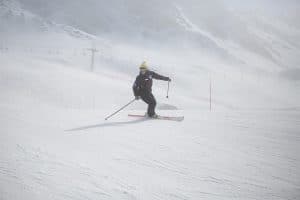
Parallel
Parallel skiing is where we aim to get to from snowplough, and is generally known as the go-to turning technique for piste skiing. Using a mixture of sliding and edging, parallel skiing is ideally executed in evenly-spaced, rounded turns down a slope while keeping your skis the same distance apart all the way along – no touching! It’s the best technique to control your speed while using the least amount of energy.
Cover image: Nick Reader
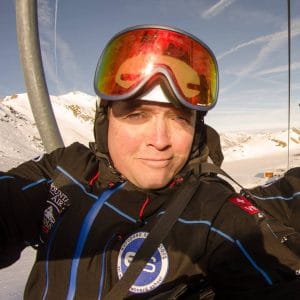
Julian Griffiths runs ES but also teaches. If you or someone you know would like to ski with Julian for a confidence-building series of lessons, contact us to make a reservation.
